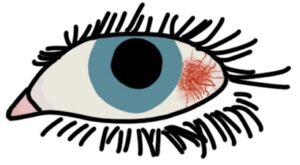Episcleritis involves benign and self-limiting inflammation of the episclera, the outermost layer of the sclera, just below the conjunctiva.
Episcleritis is relatively common in young and middle-aged adults. It is often associated with inflammatory disorders, such as rheumatoid arthritis and inflammatory bowel disease. It is not usually caused by infection.
Presentation
Episcleritis usually presents with acute-onset unilateral features:
- Localised or diffuse redness (often a patch of redness in the lateral sclera)
- No pain (or mild pain)
- Dilated episcleral vessels

Importantly, there is no photophobia or discharge and normal visual acuity (these symptoms suggest scleritis).
Applying phenylephrine eye drops helps differentiate between episcleritis and scleritis. It will cause blanching of the episcleral vessels, causing the redness to disappear. It will not affect scleral vessels and will not impact the redness in scleritis.
Management
Episcleritis is usually self-limiting and will resolve in 1-2 weeks. In mild cases, no treatment is necessary. Symptoms may be relieved with analgesia (e.g., ibuprofen) and lubricating eye drops. More severe cases may be treated with steroid eye drops.
Last updated October 2023
